If you enjoy the tropical look of palms as part of your indoor décor, there is an array of beautiful palms, cultivated indoors to select from. These lovely trees can brighten any room, lobby, or entryway with impressive heights and foliage.
Palms come in all shapes and sizes, so depending on the space you have available, there is most certainly an indoor palm for you.
This article will cover some of the more common houseplant palms, focusing on the best types of indoor palm plants to grow.
- Related Article: Indoor Palm Tree Care
Types of Indoor Palm Plants Overview
An important aspect of selecting your indoor palm, will be the palm’s size, specifically its height. Not the size you see at the time of purchase, but the size it will mature into.
If you have high ceilings, this may be less of a worry, whereas low ceilings may decide the species you eventually select. Fortunately, indoor palms do not require frequent repotting, so keeping your palm in its original container can help with height management.
Palms are members of the Arecaceae family, although some palms may belong to other families and only use the popular name “palm.” Their native habitats are tropical and subtropical areas.
Some palms will have the appearance of trees while others may resemble shrubs. With approximately 200 genera and well over 2600 various species, there are quite a few palms to choose among.
Botanically, they are different, but they can be easily recognized thanks to the impressive green fronds that will sprout on a single trunk or stem without branches. Foliage may resemble fans or feathers, offering different looks.
Here we list our favorite 11 indoor palm trees to cultivate in your home or place of business.
1. Areca Palm
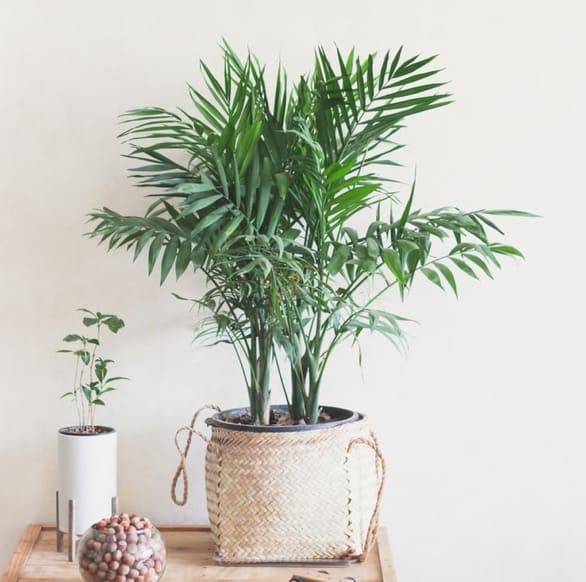
The areca palm, Botanically named Dypsis lutescens, is a popular Madagascar native and resembles bamboo. It’s a clumping palm with long, narrow, fronds on green or gold trunks. This is a pet and people-friendly indoor palm tree.
It is a rapid grower, growing five to ten inches annually until reaching maturity at approximately seven feet indoors. The areca palm can grow twenty-five feet tall when grown outdoors.
The areca prefers indirect, but bright light to partial shade, and can adapt to low-light conditions. Direct light can scorch its leaves.
Average house humidity will suffice together with temperatures in the 60° to 75°F range. Soil should be kept moderately moist and allowed to dry out between waterings. A monthly feeding of liquid fertilizer in the spring and summer months will keep the areca healthy.
Learn more in our in-depth Areca Palm guide.
2. Fan Palm
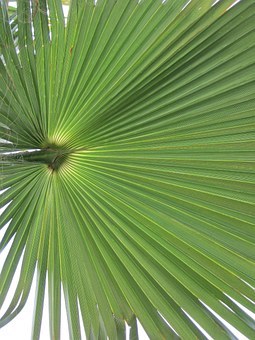
The Livistona Chinensisor Chinese Fan Palm is a popular houseplant that features a single tree trunk growing upright with fronds shaped like fans.
Native to China, Taiwan, and Southern Japan, its foliage can grow as much as six feet wide, requiring extra space wherever you put it. There are other varieties like European Fan Palms.
Outdoors, the fan palm can grow from thirty to fifty feet tall with a lifespan of approximately forty years.
The fan palm likes bright, indirect light, along with humidity levels ranging from 40% to 50%. Humidifiers are perfect if your home tends to be dry. The ideal temperature range is between 70° and 80° F in the daytime and no lower than 55° F at night.
Water the fan palm generously, but let it dry out a little between waterings. Feed this palm once in the spring and once in the summer with a slow-release palm fertilizer.
It’s non-toxic for our furry family members and small children.
Learn more in this Fan Palm guide.
3. Fishtail Palm
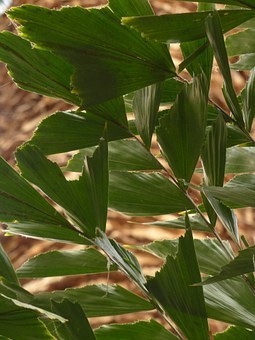
The fishtail palm features a triangular-shaped leaf that appears to split, resembling a fishtail. This explains how the Caryota mitis got its popular name, the Fishtail Palm.
Dark, glossy green serrated-edged foliage distinguishes this palm that is native to Pacific Islands, Australia, Oceania, and Asia. The full bush-like appearance due to clumping stems will generally reach about five to six feet tall.
Bright indirect light in an eastern or western-facing window is recommended together with a humidity level of about 50%. Watering this palm is tricky due to its sensitivity to chemicals, including fluoride and chlorine. Distilled water or rainwater will avoid this problem.
The ideal temperature will measure between 65° and 85° F. One to two feedings during the growing season will suffice. A monthly pinch of Epsom salt will help prevent magnesium deficiency too.
Read more about How to Care for Fishtail Palms.
4. Kentia Palm

Botanically known as the Howea forsteriana, the kentia palm is a native of Australia’s Lord Howe Island. It features a slim stem and beautiful arching dark green foliage.
They can grow to heights of up to ten feet tall indoors and forty feet outdoors. It may look to have multiple stems, but actually, it’s several kentia palms planted together for a fuller look.
The kentia palm can thrive in warm or cold temperatures and in bright indirect sunlight or partial shade. It does not require lots of light and it’s best to avoid direct sunlight to prevent leaf scorching. Temperatures of 65° to 75°F are ideal, along with average room humidity.
The kentia needs to be watered when the soil bed dries out, and it can be fed with a palm fertilizer during its growing season. It is non-toxic to both humans and animals.
Learn more about How to Care for Kentia Palms.
5. Lady Palm
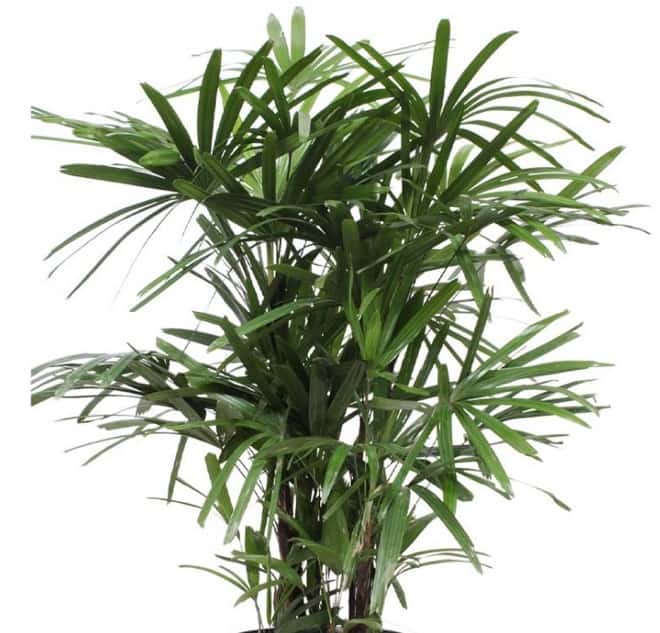
The glossy Rhapis Excelsaknown as the Lady Palm, is also called the Bamboo Palm or Broadleaf Lady Palm. It’s a slow-growing palm and admired for its lush green foliage.
It develops more than one stem and boasts glossy fan-shaped green leaves. As lower fronds die and drop, scars remain that resemble bamboo.
Native to Japan, southern China, and Vietnam, it will tolerate dry climates and shade. It is the perfect palm for offices because it will survive for some time without water. Outdoors, it is usually found as a shrub border.
Bright, indirect light is best for a thriving lady palm as well as warm temperatures between 65° and 75° F. 50% humidity and a good drenching when watering will keep this palm in good health.
Keep soil moist as completely dry soil can be lethal, so consistent moisture is key to its health. A monthly feeding during the growing season with a fertilizer diluted to half strength will be good. The lady palm is a pet-friendly tropical plant too.
Read about how to give Lady Palms proper care.
6. Madagascar Palm
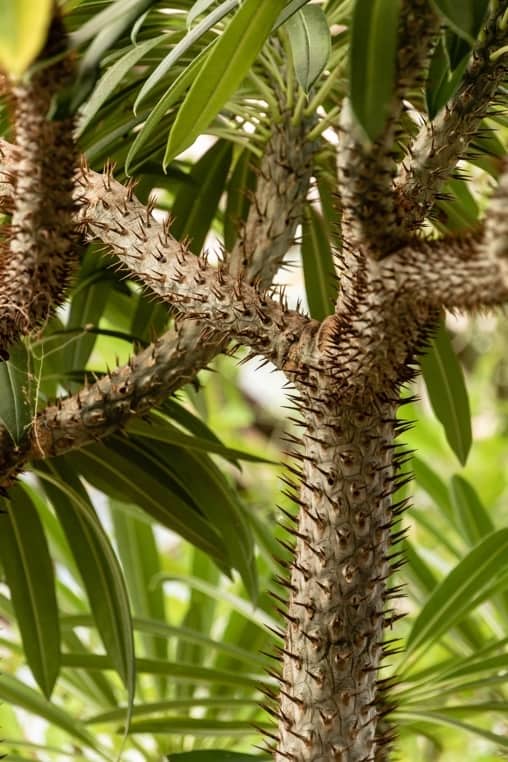
The Madagascar Palm is not really a palm and is a member of the Apocynaceae family, botanically identified as the Pachypodium lamerei. And although it may to appear to be a cactus with all the spines, it isn’t.
This stunning plant is actually a succulent. Intensely colored green leaves top the plant similar to an opened umbrella, giving it an original look. A native of Madagascar, it can reach a height of three feet in a few years.
Temperatures between 65° and 75° F are ideal for the Madagascar Palm, and it loves bright direct sunlight. This palm should remain on the dry side, so it should be watered when the soil bed dries out.
Watering should be interrupted when the plant sheds its foliage and resumed with new growth. 40% humidity will suffice and feeding at the beginning of spring and summer with a succulent fertilizer is sufficient.
Learn more about Caring for the Madagascar Palm.
7. Majesty Palm

The Ravenea rivularis, commonly called the Majesty Palm is most often grown as an indoor palm houseplant. The foliage creates a type of crown explaining its name “Majestic.”
Native to Madagascar’s humid and swampy areas, it can grow to 90 feet outdoors in its natural home. When grown indoors, it will usually reach ten feet tall.
Six to eight hours of bright sunlight daily with well-draining, moist soil is optimal. Humidity of 50% or higher is appreciated together with a minimum temperature of 65° to 85° F.
During its growing seasons, give it a couple of succulent fertilizer feedings. A monthly pinch of Epsom salt will also help prevent magnesium deficiency.
Read more about Growing Majesty Palms.
8. Parlor Palm
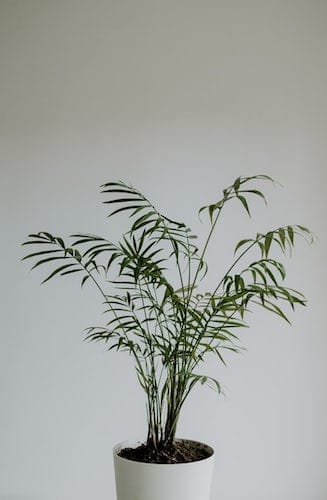
The Parlor Palm tree is a popular house palm and a smaller type of palm species when compared to others. Botanically known as the Chaemaedorea elegans and also called the Neanthe Bella Palm, it is a native of Guatemalan and southern Mexican rainforests.
It’s a compact palm that grows in clumps and features graceful arching fronds. This palm loves bright indirect light, but will do well in medium-light conditions and can even tolerate lower light locations.
Average humidity and temperatures measuring between 65° and 75° F will make for a happy and thriving indoor palm. The soil bed should dry out between waterings, allowing you to water once bi-weekly or at the most, weekly.
In the winter and its dormant period, it requires reduced watering. To feed, use palm fertilizer monthly or bimonthly. It is a non-toxic plant for both humans and their pets.
Read about How to Grow Parlor Palms.
9. Ponytail Palm
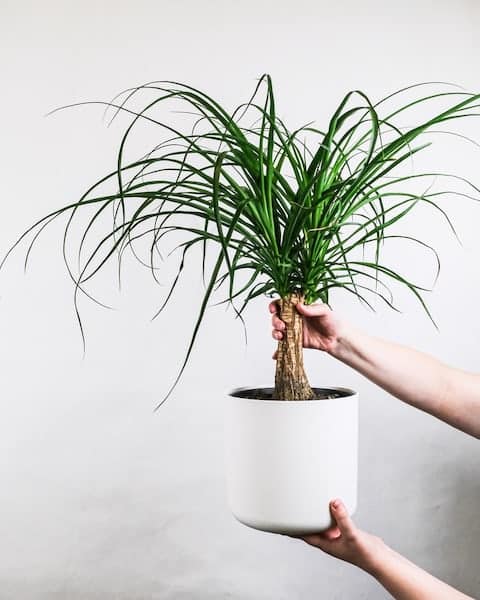
There are many beautiful palms available for indoor cultivation, but none is as unique or showstopping as the Beaucarnea recurvataor Ponytail Palm. Native to Central American arid regions, outdoors it can grow to 30 feet. Indoors, it shouldn’t grow taller than 6 to 8 feet in height.
Featuring a bulbous trunk, it boasts stunning foliage that resembles long curly hair growing from atop its trunk. Surprisingly, the ponytail palm is really a member of the Asparagaceae family and also not a genuine palm.
Preferring bright light, the ponytail palm can still tolerate low light conditions, although 6 hours of direct sun is appreciated. Average home temperatures work for this palm and the soil bed (preferably a cactus mix) should be relatively dry.
There’s no need for regular waterings in winter months. A cactus fertilizer applied two to three times annually will suffice. It is also non-toxic for pets and humans.
Learn more about Ponytail Palm Care.
10. Pygmy Date Palm

While most date palms grow to 75 feet in height, the Pygmy Date Palm or Phoenix roebeleniiis a dwarf palm that won’t get there and is suitable for indoor cultivation. Pet-friendly, these little trees can grow from 4 to 8 feet indoors.
Native to Southern China, it flaunts narrow, feathery fronds in varying shades of green. This little palm prefers full sunlight, but will adapt to partial shade or filtered light. Bright natural light will help it remain in good health.
Normal room temperatures ranging between 65° and 75° F and moderate humidity will go a long way. Try misting if your home is on the dry side. Even though it is drought tolerant, the soil bed should remain moist. Palm fertilizers are best for feeding monthly in spring and summer.
Read this in-depth Pygmy Date Palm Care Guide.
11. Sago Palm
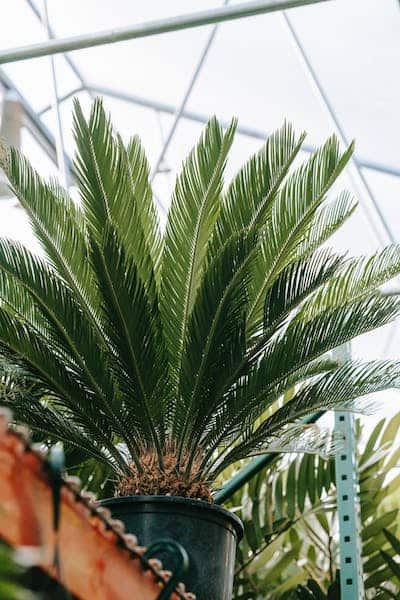
The Sago Palm is not a true palm, either, but it’s a very popular indoor plant. Its trunk resembles a pineapple with feathery foliage on the top. A native of Japan, it is botanically known as the Cycas revoluta.
This palm prefers direct sunlight or very bright indirect light. It can manage in partial shade, but low light conditions are inappropriate and can hurt its growth.
As a lover of warm, humid conditions, most average home temperatures will be more than adequate. It should only be watered if the growing medium feels dry when touched. Feed this palm monthly with a diluted liquid fertilizer.
As a houseplant, it should grow to approximately three feet tall. Unfortunately, the Sago Palm is toxic to both humans and pets.
Types of Indoor Palm Plants Final Thoughts
Indoor palm plants are some of the easiest types of tropical plants to care for. They require minimal maintenance and easy to keep alive, even if you don’t have much time to spend tending them.
If you want an exotic look without having to worry about watering too often, then consider our favorite indoor palm plants above.
There are many other types of palms out there to take a look at if these aren’t for you. Check out some of our in-depth palm care guides:

